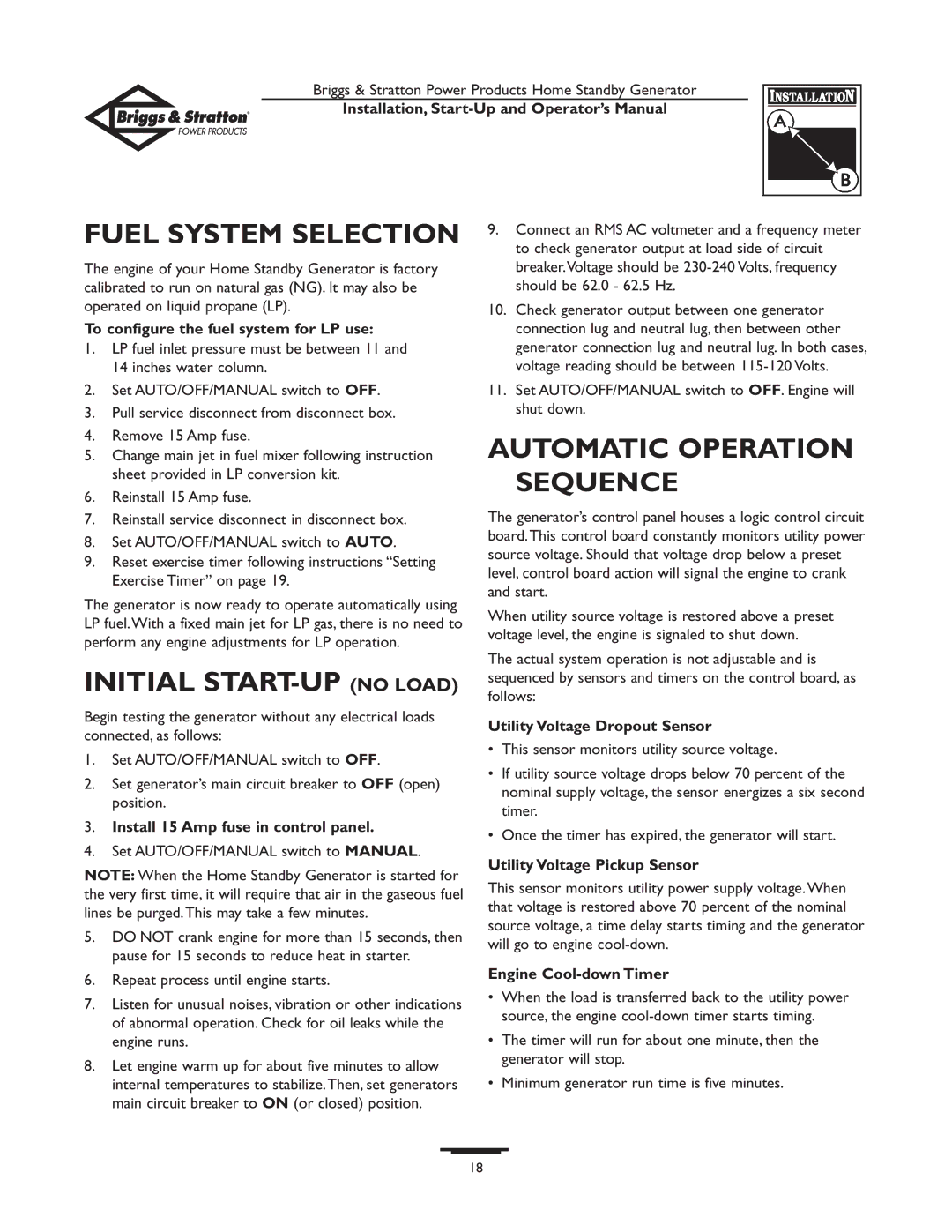Home Standby Generator
Table of Contents
Important Safety Instructions
Do not dispose of battery in a fire
Operate generator only outdoors
Amp fuse Before working on the equipment
Save These Customer Instructions Responsibilities
Installer Responsibilities
Installation Assistance
Introduction
Battery
Know Your Home Standby Generator
Oil Fill
Know Your Control Panel
AUTO/OFF/MANUAL
Installation Procedures
Owner Orientation
Shipment Contents
Lifting the Generator
Home Standby Generator Location
Essential Circuits
Essential Circuit Selection
Device Running Watts
Fuel Inlet Dimensions
Removable Roof and Access Door
Disconnect Box Mounting Guidelines
Consider the following factors when planning to
Install the fuel supply system
Gaseous Fuel System
To Home Standby
Fuel Consumption
From Fuel
Load
Fuel Pipe Sizing
10ft 15ft 20ft 30ft 40ft 50ft 60ft 70ft 80ft 90ft 100ft
Fuel Comparison Chart
Physical Properties Propane Natural Gas
Withdrawal Rate 32F 20F 10F 30F 40F
Wire Connections
Before Initial START-UP
Servicing the Battery
Battery Connection
Charging the Battery
Fuel Supply System
Fuel System Selection
Automatic Operation Sequence
Initial START-UP no Load
Setting Exercise Timer
Installation Inspection
To perform the Set Exercise procedure
Automatic Operation
Specifications
Fault Detection System
Servicing the System
No LED Discharged Battery
Number of LED Flashes Fault Description
Reset Fault Detection System
Engine Fail To Start
Changing Oil
Generator Maintenance
Changing Engine Oil and Filter
Changing Oil Filter
To Clean the Generator
When Calling the Factory
Storage
Troubleshooting
Problem Cause Correction
Installation, Start-Up and Operator’s Manual
Schematic
Wiring Diagram
Exploded View Main Unit
Description
Parts List Main Unit
Optional Accessories Not Illustrated
Items Not Illustrated
Exploded View Enclosure
Parts List Enclosure
Exploded View Control Panel
Parts List Control Panel
ADAPTER, Mounting,Alternator
Exploded View and Parts List Alternator
HARNESS,Wire DC Charge
SCREW, M5 .8 x 10 Taptite
Limited Warranty
7KW and 10KW Home Generator
Tabla DE Contenido
Manual de Instalación,Arranque y Operario
Sensor de Excitación de Tensión de la Compañía
Advertencia
Peligro
Precaución
Los generadores producen un voltaje muy poderoso
Responsabilidades DEL Cliente
Conserve Estas Instrucciones
Introducción
Responsabilidades DEL Instalador
De Nivel de Aceite
Conozca SU Generador DE Reserva
Etiqueta del Motor Tapón de Llenado y Varilla
Tapón de Llenado y Varilla de Nivel de Aceite Permite
Disyuntor Interruptor
Conozca EL Panel DE Control
Fusible de
Fusible de 15 Amperios Protege los circuitos de control de
Orientación Para EL Propietario
Procedimientos DE Instalación
Contenido de la Caja
Elevación del Generador
Ubicación del Generador de Reserva
Circuitos Fundamentales
Selección de los Circuitos Fundamentales
Dispositivo Vatiaje de
Dimensiones de la Entrada de Combustible
Directrices de Montaje del Cuadro de Desconexión
Techo y Puerta de Acceso Desmontables
Sistema DE Combustible Gaseoso Advertencia
El generador de reserva viene preparado de fábrica para
Consumo de Combustible
Gas Natural Vapor de PL
Dimensiones de la Cañería de Combustible
Gas Natural peso específico =
Propano Líquido PL peso específico =
Cuadro de Comparación de Combustibles
Propiedades físicas Propano Gas natural
Tasa de consumo 32F 20F 10F 30F 40F
Conexiones DE Cables
Antes DEL Arranque Inicial
Cargar la Batería
Conexión de la Batería
Sistema de Suministro de Combustible
Servicio la Batería
Selección DEL Sistema DE Combustible
Arranque Inicial SIN Carga
Secuencia DE Operación Automática
Ajuste DEL Temporizador DE Ejercicio
Inspección Posterior a LA Instalación
Temporizador de enfriamiento del motor
Sistema DE Detección DE
Especificaciones
Operación Automática
Fallas
No se Enciende el LED Batería Descargada
Cantidad de Destellos del LED Descripción de la Falla
Restablecimiento del Sistema de Detección de Fallas
Baja Presión de Aceite
Cambio del Filtro de Aceite
Mantenimiento DEL Generador
Cambio del Aceite del Motor y del Filtro
Cambio del Aceite
Almacenamiento
Para Limpiar el Generador
Si Llama a la Fábrica
Reparacion DE Averias
Garantía Limitada
7KW et 10KW Generador de Doméstico
Fonctionnement Automatique
Manuel dInstallation, Démarrage et Utilisation
Table DES Matières
Entretien DE LA Génératrice
Avertissement
NE touchez PAS les fils dénudés ou les boîtiers
Conservez CES Instructions
Responsabilités DE Linstallateur
Aide À Linstallation
Introduction
FAMILIARISEZ-VOUS Avec Votre Génératrice D’ÉTAT D’ATTENTE
Filtre à Air Et Jauge dHuile Filtre à lHuile
FAMILIARISEZ-VOUS Avec LE Tableau DE Commande
15 Ampères
Disjoncteur Interrupteur
Procédures Dinstallation
Conseils AU Propriétaire
Emplacement du Génératrice d’état d’Attente
Contenu de la Boîte
Soulèvement de la Génératrice
Circuits Essentiels
Sélection des Circuits Essentiels
Appareil Watts
Dimensions de lOrifice dAdmission du Combustible
Directives dAssemblage du Boîtier de Débranchement
Toit Amovible et Porte dAccès
LE Système DE Combustible Gazeux Avertissement
Le génératrice d’état d’attente a été réglé en usine pour
Consommation de Combustible
Gas Naturel Vapeur PL
Grosseur du Tuyau de Combustible
Gaz Naturel densité = 0,65
Gaz de Pétrole Liquéfié GPL densité = 1,50
Charte de Comparaison des Combustibles
Propriétés physiques Propane Gaz naturel
Raccords DE Fils
Avant LE Démarrage Initial
Rechargez la Batterie
Branchement de la Batterie
Système dAlimentation en Combustible
Entretien de la Batterie
Démarrage Initial Sans
Capteur de Prise en Charge de la Tension de Service
Sélection DU Système DE Combustible
Séquence DE Fonctionnement Automatique
Réglage DE LA Minuterie DU Cycle Dexercice
Vérification Installation
Warranty Registration Box Milwaukee,Wisconsin
Minuterie de Refroidissement du Moteur
Système DE Détection DES Pannes
Caractéristiques
Fonctionnement Automatique
Entretien du Système
Aucun DEL Batterie déchargée
Clignotements Du Voyant
Réarmement du Système de Détection des Pannes
Faible Pression dHuile
Changement du filtre à huile
Entretien DU Générateur
Changement dHuile à Moteur et de Filtre
Vidange de lHuile
Remisage
Pour Nettoyer le Générateur
Communications avec le Fabricant
Dépannage
Remarques
Garantie Limitée
7KW et 10KW Génératrice Résidentielle

